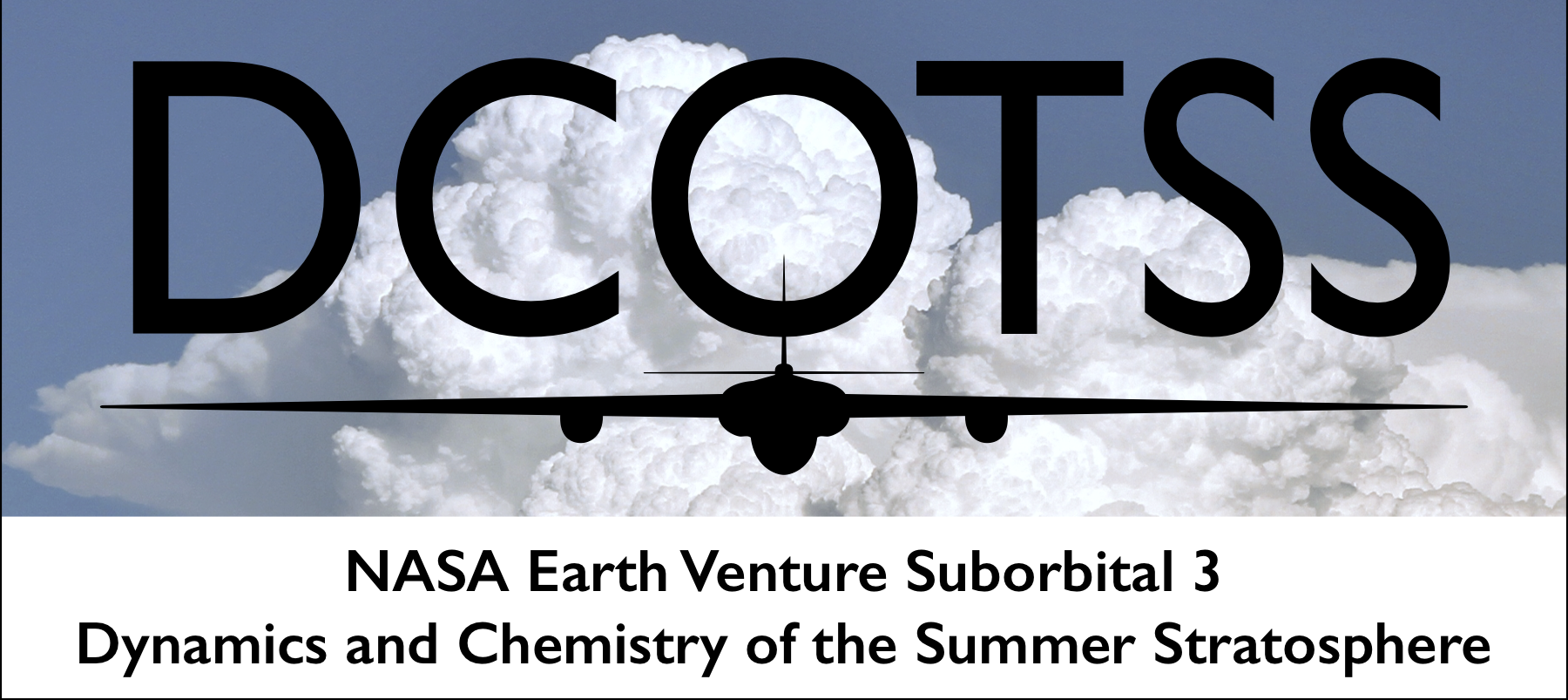

| Overview | Science | Project | Data | People | Publications | News |
The primary goal of the DCOTSS mission is to understand how dynamical and chemical processes interact to determine the composition of the extratropical stratosphere, and how that composition may change in response to ongoing changes in the climate system. The phenomena involved, which range from turbulence and deep convection to the continental- and planetary-scale circulations, require observing systems and models that cover a similarly wide range of space and time scales. DCOTSS employs a novel combination of airborne in situ instruments, ground and satellite-based remote sensing, meteorological analyses, and dynamical and chemical models to address the specific scientific questions discussed below.
There are large uncertainties in estimates of the amount of tropospheric air injected into the stratosphere by convection. These uncertainties arise in part from sparse aircraft sampling, and in part from an incomplete understanding of how often the overshooting storms inject significant amounts of water into the lower stratosphere. By successfully targeting convective outflow in the stratosphere, DCOTSS transformed the observational record, recording hours of high-quality data from a broad range of storm types and environmental conditions over a large part of the summer season. The detailed in situ observations from the ER-2 are being combined with regional-scale observations of overshooting frequency and magnitude provided by NEXRAD, GOES, and MLS to estimate the total transport by convection during the summer season.
It is not currently known how much of the stratospheric air in the North American Monsoon Anticyclone (NAMA) originates from convection over the U.S., how much comes from convection over the Sierra Madre Occidental of Mexico, and how much is downstream transport from the Asian monsoon circulation. DCOTSS targeted convective plumes originating in the U.S. and the Sierra Madre Occidental to determine the altitude of associated convective injection and the magnitude of water inputs through direct measurement. In situ measurements and back trajectories are being used to investigate long distance transport from Asia.
Some DCOTSS flights crossed the NAMA boundary and observed the transition between the interior and exterior of the anticyclone. DCOTSS took advantage of its unique opportunity to combine in situ measurements of atmospheric composition inside and outside of the NAMA with dynamical and chemical models to quantify the residence time for convectively injected air within the anticyclone (Clapp et al., 2019; Clapp et al., 2022; Chang et al., 2023; Sayres et al., 2024).
In situ observations from the ER-2 are being combined with high-resolution numerical models of convective systems to investigate the mixing processes at the boundaries of overshooting updrafts.
Very short-lived substances (VSLSs) are a broad class of primarily chlorine- and bromine-containing gases that have nonuniform tropospheric abundances and lifetimes less than 6 months. Chlorinated VSLSs predominantly originate from anthropogenic sources, while brominated VSLSs mainly come from natural sources. Due to their short lifetimes, VSLSs release their halogen content shortly after entering the stratosphere and therefore play an important role in lower stratospheric chemistry, leading to increased ozone depletion. Quantification of VSLS halogens has historically been significantly more difficult than for long-lived halogen compounds because of their short lifetimes and atmospheric variability. VSLSs are of particular interest because they represent chlorine and bromine species emitted into the atmosphere that are not controlled under the Montreal Protocol. While total chlorine and bromine entering the stratosphere from long-lived sources is in decline, VSLSs are not. Chlorine-containing VSLSs, which are predominately produced by industry, have shown relatively large increases in recent years. DCOTSS provided important new data on the abundance of VSLS species in the stratosphere.
Non-catalytic reservoir species (HCl and ClONO2) typically comprise more than 95% of inorganic chlorine (Cly) in the mid-latitude LS. However, enhanced water vapor and low temperatures in the NAMA can enable the conversion of Cly to free radical form on ubiquitous binary sulfate-water aerosols, and these surfaces also drive the conversion of NOx into reservoir species (HNO3, ClONO2). Satellite measurements have provided unprecedented global long-term data sets, but to examine localized chemical changes, targeted, high-resolution, in situ measurements are needed to complement and extend the satellite data. Studies are currently underway to understand the potential for ozone destruction in the summer lower stratosphere.
Very little is known about: (1) the sources and sinks of the organic aerosols in the summer stratosphere, although it is clear that its source must be tropospheric (anthropogenic and natural), (2) the phase of the organic fraction, and (3) the impact of organic aerosol on the chemistry and radiative properties of the stratosphere. DCOTSS observations collected important new data on the abundance and composition of aerosol paricles in the lower stratosphere.
The eruption of the Hunga-Tonga volcano provided a target of opportunity for DCOTSS sampling of volcanic material. Unfortunately, material from Hunga-Tonga was not reachable by the ER-2 aircraft during the DCOTSS deployments.